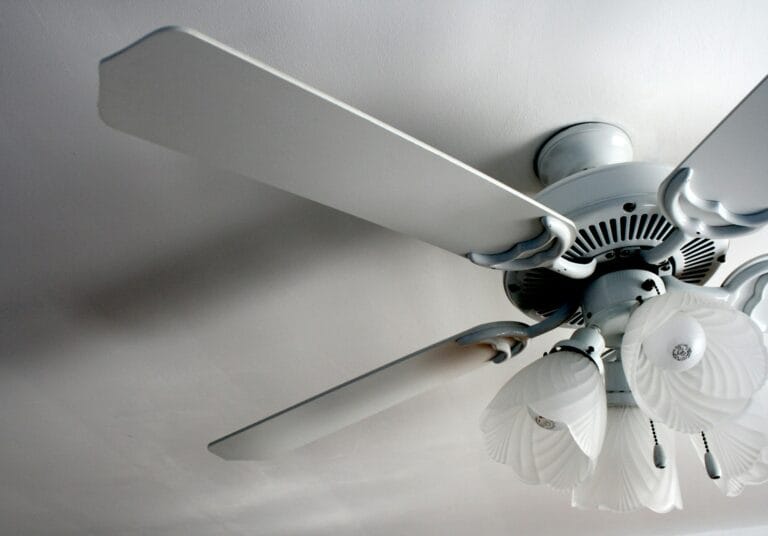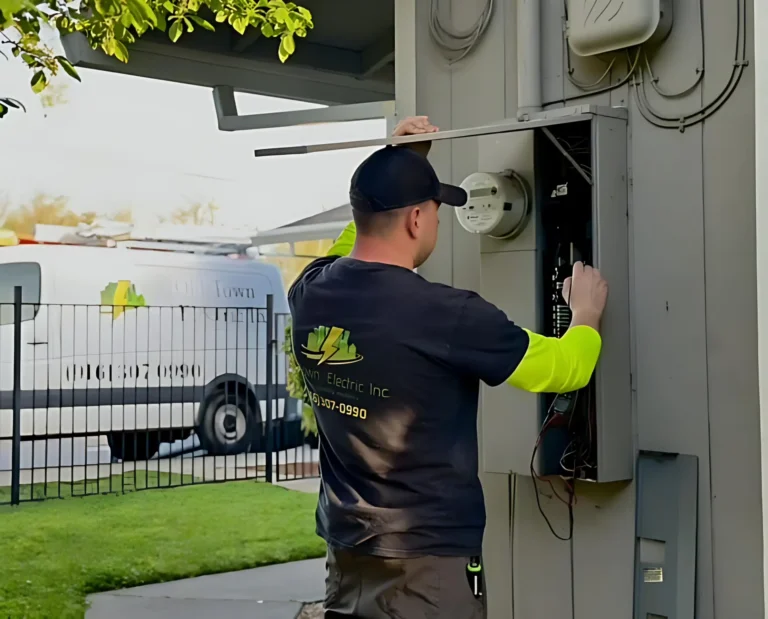Walk into enough older homes around Sacramento, and you’ll eventually run into it: Knob and Tube wiring. Maybe tucked away in an attic corner. Maybe running along basement joists. Sometimes patched into a modern panel, other times hidden behind plaster walls.
On the surface, it looks harmless, ceramic knobs and tubes holding old copper wires in place. But here’s the thing: Knob and Tube wiring is a century-old system, and it simply wasn’t designed to handle today’s electrical loads. Pair that with aluminum wiring, which became popular in the 1960s and 70s, and you’ve got two outdated systems that have caused more headaches (and house fires) than I care to count.
If you own a home in Sacramento, Carmichael, or anywhere in the Valley, it’s worth knowing the risks. This isn’t just about comfort. It’s about safety.
Table of Contents
What Exactly Is Knob and Tube Wiring?
Knob and Tube wiring was standard in homes built from the late 1800s through the 1930s. It used porcelain knobs to secure wires and ceramic tubes to pass wires through framing. At the time, it was clever and durable.
But fast-forward to 2025, and the flaws are clear:
- No grounding. These systems lack a ground wire, leaving your home vulnerable to shocks and surges.
- Overheating risks. Insulation around wires degrades over time, exposing bare copper.
- Incompatibility. Modern appliances, microwaves, air conditioners, electric vehicles, pull far more current than the wiring was built for.
- Insurance issues. Many carriers refuse coverage or charge higher premiums for homes with active Knob and Tube wiring.
In my experience, it’s not uncommon to find Knob-and-Tube patched into newer wiring. That’s when things get really dicey. Old and new systems don’t always play nicely, and the connections often become hot spots for failure.
Sacramento Homes and Knob and Tube Wiring
Here in Sacramento, neighborhoods like East Sacramento, Land Park, and parts of Midtown are full of charming Craftsman bungalows and Victorians. Beautiful architecture. Sturdy woodwork. But under those plaster walls? I’ve opened panels in 1920s homes near McKinley Park that still ran mostly on Knob-and-Tube.
One client in Curtis Park called after noticing lights dimming every time the microwave ran. Sure enough, we found brittle cloth insulation crumbling in the attic. Wires spliced with tape decades ago. It wasn’t a matter of if it would fail, it was when.
Sacramento summers only make matters worse. Attics hit 120°F easily. That heat accelerates the breakdown of old insulation. Combine that with today’s high electrical demand, air conditioners humming all day long, and you’ve got a recipe for disaster.
The Trouble with Aluminum Wiring
Knob-and-Tube isn’t the only outdated system causing problems. In the mid-1960s through the late 70s, aluminum wiring was installed in millions of homes across California. It was cheaper than copper, and builders jumped at the cost savings.
The issue? Aluminum expands and contracts more than copper when heated. That constant movement at connections leads to:
- Loose terminals
- Overheating
- Potential fire hazards
I’ve seen outlets in Citrus Heights and Elk Grove with scorched receptacles because of aluminum wiring. The homeowners had no idea until a faint burning smell gave it away.
Unlike Knob-and-Tube, aluminum wiring isn’t always visible unless you open up switches and outlets. That’s why a professional inspection is so important if your home was built between 1965 and 1975.
Why Outdated Wiring Is More Dangerous Today
Fifty years ago, households didn’t run five smart TVs, two gaming systems, laptops, electric dryers, and Level 2 EV chargers at once. A kitchen might have had a fridge and a toaster. Maybe a coffee pot.
Now? The average Sacramento home has triple the electrical demand. Outdated systems like Knob and Tube wiring or aluminum circuits weren’t designed for it. The result is:
- Overloaded circuits
- Overheating connections
- Tripped breakers (if you’re lucky) or smoldering outlets (if you’re not)
I’ve seen breakers in Arden Arcade trip repeatedly, only for us to discover Knob-and-Tube buried under blown-in insulation. The wires were literally cooking unseen.
Signs You Might Have Knob and Tube Wiring
Not sure if your home has it? Look for:
- Porcelain knobs nailed to beams or joists
- Ceramic tubes where wires pass through wood
- Wires with cloth insulation, often fraying or brittle
- No ground wires in outlets (just two-prong receptacles)
If your home was built before 1940 in Sacramento, there’s a good chance some Knob-and-Tube is still in use. Even partial systems can be risky if tied into newer wiring.
What About Aluminum Wiring?
You may have aluminum wiring if:
- Your home was built between 1965–1975
- Outlets or switches feel warm to the touch
- You notice flickering lights
- Breakers trip without obvious cause
Aluminum wiring is often stamped with “AL” on the sheathing, but you won’t know for sure without pulling a device or having a pro take a look.
Which Solution Is Best for Sacramento Homeowners?
The most popular fixes that we suggest are as follows:
1. Complete Rewiring
The safest, most reliable option. Replacing Knob-and-Tube wiring with modern copper circuits and grounded outlets brings your home up to today’s standards.
2. Aluminum Wiring Pigtailing
For aluminum, one solution is to install short copper “pigtails” at outlets and switches using special connectors. This reduces the expansion/contraction issue.
3. Panel Upgrades
Even if you replace wiring, older panels may not have the capacity for today’s needs. A 200-amp service is standard for Sacramento homes now.
4. Incremental Replacement
Some clients opt for phased upgrades for larger homes, beginning with the HVAC circuits, kitchens, and bathrooms. It addresses the areas with the highest risk first while spreading out the cost.
Cost Considerations
Prices vary depending on home size and complexity, but here’s a ballpark for Sacramento:
| Service | Average Cost Range | Notes |
|---|---|---|
| Full rewire (1,500 sq ft home) | $12,000–$20,000+ | Higher in older plaster homes |
| Aluminum pigtailing | $1,500–$5,000+ | Depends on # of outlets/switches |
| Panel upgrade (200 amp) | $3,500–$6,000+ | Includes new breakers, permits |
It’s an investment, but compare that to the cost of a house fire, or the peace of mind knowing your family is safe.
Why Local Expertise Matters
Sacramento has its quirks. Our hot summers stress electrical systems. Our older neighborhoods have homes nearly a century old, with layers of remodels and additions. I’ve seen Knob-and-Tube running right alongside modern Romex in Oak Park duplexes. I’ve seen aluminum spliced with whatever a homeowner had on hand, sometimes lamp cord.
If you ask us, local knowledge makes all the difference. Electrical contractor familiar with Sacramento’s housing stock knows where to look, what to expect, and how to plan a fix that won’t wreck your budget or your walls.
When to Call a Professional
If you notice any of the following, it’s time to pick up the phone:
- Flickering lights
- Burning smells near outlets
- Frequently tripping breakers
- Two-prong outlets in an older home
- Electrical work without permits
Even if your home “seems fine,” the risks of Knob-and-Tube wiring or aluminum connections are too big to ignore.
Safety First
Outdated wiring isn’t just inconvenient. It’s dangerous. Sacramento homeowners who hold onto Knob-and-Tube wiring or rely on aluminum systems are taking a gamble with fire and shock hazards.
From what I’ve seen over the years, the homes that address these issues early save money, stress, and sometimes lives. Whether you’re in East Sac, Carmichael, or down in Elk Grove, the safest step is an inspection, and a plan for upgrades.
At Old Town Electric, we’ve helped homeowners across the region retire outdated wiring safely and affordably. If you’re unsure about what’s hiding behind your walls, give us a call. It’s better to know than to wonder.



